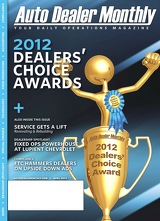Auto Dealer Monthly Magazine is the daily operations publication serving the retail automotive industry. This automotive publication serves dealer principals, officers and general managers with the latest best practices.
Page 24 of 62
industry expert / accounting
Service and Parts Profitability
David Keller, CPA, CFE, is a partner with CliftonLarsonAllen, a top ten nationwide CPA firm with extensive experience in serving the new, used, heavy truck, utility trailer and buy-here pay-here industries. Contact him at 314.925.4317.
DKeller@AutoDealerMonthly.com G
ross profit percentages are very important if you want to show a
profit in the service and parts departments. You should set your minimum goals to achieve 70 percent for labor and 40 percent for parts. Accessories are normally priced somewhat lower, with a gross profit of approximately 10 percent to 30 percent, depending on what item is
sold and what the competitive pricing is.
There are some who would argue you can't afford to charge yourself retail rates for internal labor and parts. The difference between these gross profit percentages and what I see on some financial statements is normally immaterial to the vehicle gross profit when reviewing the
averages for all repair orders. To compute the labor rate you should charge, take your aver- age labor hourly technician cost, including any incentives for hours or parts sold, and divide it by 30 percent (100 percent less the 70 percent gross profit you want to make) to arrive at the hourly labor rate you should charge yourself or others. For exam- ple, if your hourly pay is $15, then divide $15 by 30 percent to arrive at a $50 per hour labor rate. This will allow you to make a 70 percent gross profit on your labor charged.
To compute the parts retail price, you would use the same formula. For example, if your parts cost is $15, then divide $15 by 60 percent (100 percent less the 40 percent gross profit you want to make) to arrive at a $25 retail parts price. This will allow you to make a 40 percent gross profit on your parts sold. Most parts system setups use a markup method rather than a gross profit method. If this is the case, then you should use at least a 67 percent markup to achieve a 40 percent gross profit on your financial statement.
On repairs, you will normally have approximately $1 of labor charged for every $1 of parts sold. If so, you will aver- age 50 percent to 55 percent combined gross profit on labor and parts sales. On maintenance-type work, there will normally be more labor and fewer parts, as you
22
are basically running through a checklist to see what the vehicle needs.
What work should you sublet? If you have the stalls and qualified technicians available, you want to do as much of the work yourself rather than give another shop the gross profit you would be making on the repair. You should try to main- tain a 15 percent gross profit on any sublet labor you sell. This would include towing, tires, glass, etc.
I see many dealers who are subletting repairs they could complete themselves. If you have the shop space, you should be completing these repairs yourself even if who you are using is cheaper. The reason is you will make some profit even at the cheaper price, which will go straight to the bottom line as profit and utilize unused shop space.
Accounting for all available labor hours versus the flat-rate hours turned will provide you with a technician efficiency report. The technicians should have two timecards. One is for clocking in normally at the start of the day, clocking out/in for lunch and clocking out at the end of the day. This timecard will track the total time the technician is on site. The second timecard is to track the hours charged to each repair order so the labor can be costed out and the hours turned can be charged to the appropriate sales account.
